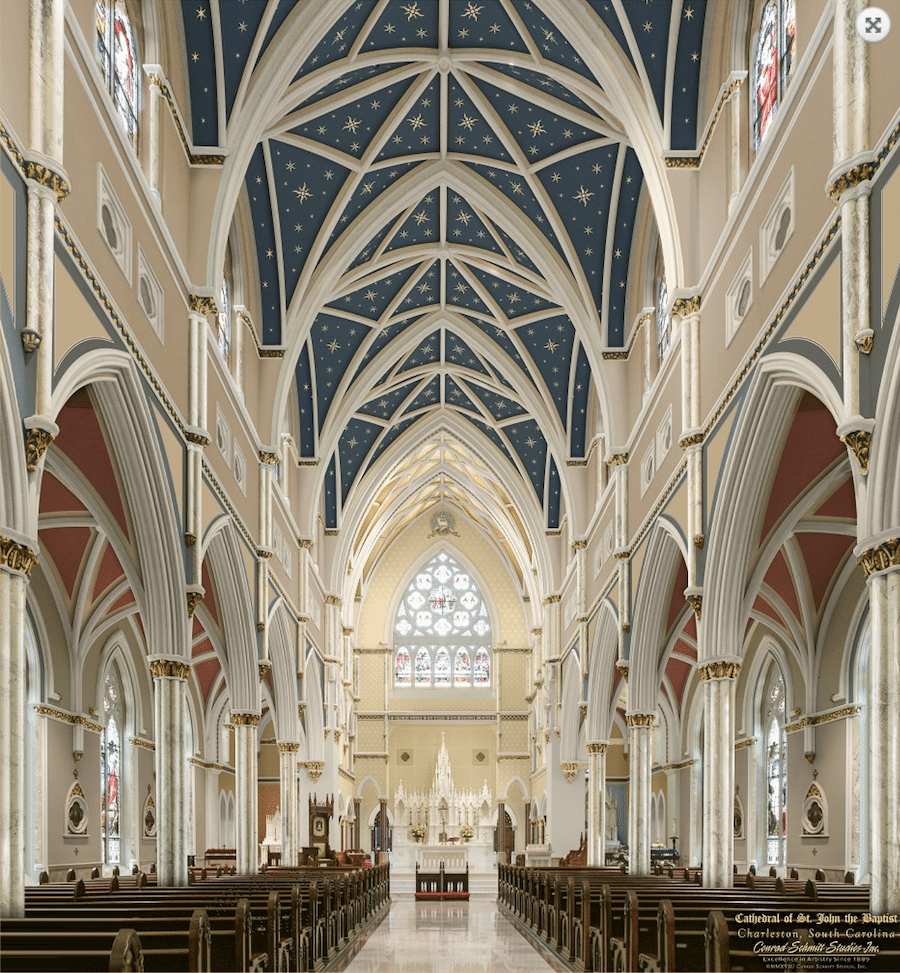
Sights and Sounds of Broad Street: The Cathedral of St. John the Baptist
The Cathedral of St. John the Baptist is a destination for many visitors and Charleston locals who stroll down Broad Street. Recognized by its stunning tall steeple and intricate design, the brownstone church was designed by architect Patrick Keely in the English Gothic Revival style in 1907. Its history and elegance have made it a powerful part of Charleston’s historic experience.
Keely was an Irish-born Brooklyn architect who gained notoriety for the construction of almost 600 parish churches and cathedrals throughout his career. In 1854, the architect was commissioned to design the gothic chapel. His project created a 219-feet tall structure adorned with a spindly steeple and 6-foot-tall and 9-feet-wide bronze cross. This accomplishment was celebrated and enjoyed for a few years before something tragic came upon the holy church.
The Great Fire of Charleston swept through and overtook the building in 1861, burning it down to the ground. After this sudden tragedy, the church body suffered the destruction of the esteemed church during a time of financial struggles caused by the Civil War’s ramifications. Unable to pay for it to be rebuilt immediately, the parish waited patiently for 29 years before contracting Keely again.
In 1888, Keely brought relief to the congregation by rebuilding the cathedral. Keely’s English Gothic style influenced tall, arrow-arched ceilings, and the interior was detailed with ornate metal and bronze elements and plaster walls. The Flemish oak pews faced the white Vermont marble arches. Some of the details of the original building, such as the iconic steeple and decorative walls, had to be left out due to lack of funds. Even still, the resilient community rejoiced in the consecration of the building in 1907.
Windows are a classic way of sharing a cathedral’s doctrine. Stained glass windows adorn each entrance, depicting symbols like the Papal coat of arms and the seal of South Carolina. Fourteen windows in the nave depict the Life of Christ and His Nativity to the Ascension, and above the altar is a five-light window inspired by Leonardo da Vinci’s “Last Supper.” In the clerestory, the high section of the wall that contains a series of windows, guests can look up to see images honoring the four Evangelists: Matthew, Mark, Luke, and John. And finally, the circular rose window represents the famous scene of the Baptism of Jesus by St. John the Baptist.
Through the last century, the cathedral has overseen many repairs and renovations, such as regaining its steeple in 2010. Recently, the church funded a 10-month renovation project through the “Restoring All Things in Christ,” campaign, which raised $1.8 million for interior repairs.
Dan Doyle, Senior Vice President and Chief Operating Officer of The Beach Company, participates in the parish’s Finance Council and joined the efforts as a co-chair for the renovation committee. As a member of the congregation, Dan was excited to take part in the meaningful mission to update the cathedral’s interior.
“The cathedral is one of the most recognizable buildings on Broad Street,” Dan said. “The church steeples play an important role in the Holy City and each historic church building plays a part in that identity.”
Dan compared the church to Charleston’s museums, art galleries, and government buildings, which encapsulate the city’s culture and history.
The project included the repair of damaged plaster and peeling paint, repainting the interior, updating lighting design, replacing the HVAC and air handlers, and updating the sound system.
“When you go inside, it doesn’t matter what your faith is, the details are awe-inspiring, and that is what was accomplished by this renovation project,” he said. “It provides you with a sense of well-being and comfort. That to me is exactly what architecture is intended to do.”
A team of highly skilled craftspeople from Conrad Schmitt Studios, Inc, were chosen to help due to their experience in the restoration of places of worship across the country. The team joined the efforts of the parish renovation committee to improve the building while preserving and respecting the building’s history.
On August 1, the cathedral re-opened its doors with a powerful and emotional response from its members and Charleston neighbors. It is now open for guests to roam inside and witness the decorative interior of faux marbling, gold leaf accents, and ceiling murals of the sky and heaven, which are just a few of the enhancements included in this project.
The Cathedral of St. John the Baptist has successfully welcomed improvements to maintain its legacy as the “mother church” of the Catholic Diocese of Charleston.
Located down the street from The Jasper, this Broad Street landmark is accessible for residents and visitors to enjoy the immaculate architecture.
“The Jasper is the gateway to Charleston’s Historic District, and the churches play a significant role in the history of Broad Street,” Dan said. “The cathedral allows people to experience the history.”
Learn more about The Cathedral of St. John the Baptist by visiting https://charlestoncathedral.com/.